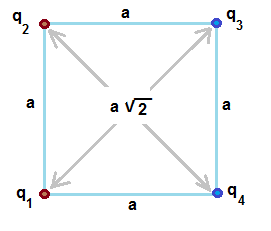Navigation
Mechanics
Heat and Thermodynamics
Magnetism
Geometrical Optics
Wave Optics
Electrostatics
Current Electricity
Electric Field And Potential
Electric field and electric field intensity:
- The space around an electric charge in which its influence can be experienced is known as electric field.
- The electric field intensity at any point is equal in magnitude to the force experienced per unit test charge placed at that point and is directed along the direction of the force experienced.
i.e
- Electric field intensity is a vector quantity. Electric field intensity due to positive charge is always away from the charge and due to negative charge is always towards the charge. The unit of electric field intensity is Newton/Coulomb () or Volt/meter () .
- The electric field due to point charge 'q' at a distance 'r' is: .
- Also where V is potential difference and d is the potential difference between plates.
- The resultant electric field at any point is equal to the vector sum of electric field at that point due to various charges i.e,
- The magnitude of the resultant of two electric fields is given by:
- Electric field intensity:
- due to linear charged conductor = where is the linear charge density
- due to plane charged conductor = where is the surface charge density
- due to infinite plane sheet = where is the surface charge density
Electric lines of force:
- The line or a curve along which an isolated +ve charge would travel if it is free to move in an electric field is known as electric lines of force. They start from positively charged body and end at a negatively charged body.
- No electric lines of force exist inside a charged body.
- Tangent to the line of force at any point gives the direction of electric intensity at that point.
- No two electric lines of force can intersect each other.
- The electric lines of force are always normal to the surface of a conductor, both while starting and ending on the conductor.
- They never form closed loops.
- They are always perpendicular to equipotential surface.
- In uniform electric field, the electric lines of force are equidistant, parallel straight lines.
Electric dipole:
- Two equal and opposite charges separated by a small distance constitute an electric dipole.
- It is a vector quantity and is denoted by .
- The magnitude of electric dipole between the charged '+q' and '-q' separated by distance 'd' is given by :
- Its direction is from negative charge to positive charge.
Electric potential:
- Electric potential at a point is defined as the amount of work done in bringing a positive charge from infinity to that point.
- If many charges are present then:
- The potential difference between A and B is work done in bringing a unit positive test charge from A to B
, where are the distance of points A and B from the unit positive test charge.
- The potential due positive charge is positive and vice versa.
Equipotential surface:
- The locus of all points which are at the same potential is known as equipotential surface.
- No work is done to move a charge from one point to another in an equipotential surface.
Electric potential energy:
- It is the total amount of work done in bringing the various charges to their respective positions from infinitely large mutual separations.
- It is denoted by
- For two charge system:
- For three charges in an equilateral triangle of side 'r':
- For 4 charges in a square of side 'a':

Electric flux ():
- It is the product of electric field intensity and area normal to the electric field intensity.
- It is a scalar quantity.
- It is given by:
- Electric flux is positive if it enters the area and is negative if it leaves the area.
- Electric flux is zero if the field line is parallel to the plane.
Gauss's theorem:
- It states that the total electric flux coming out of a closed body is equal to times the net charge enclosed by the body.
- =
- Gauss's theorem is applicable for closed surface only.
- Even if the total net flux through a closed surface is zero, the electric field E at the gaussian surface may not be zero.
- Total flux from cube with charge +q placed at the center is : and the flux through one face is :
- Electric flux is independent of the radius of closed surface.